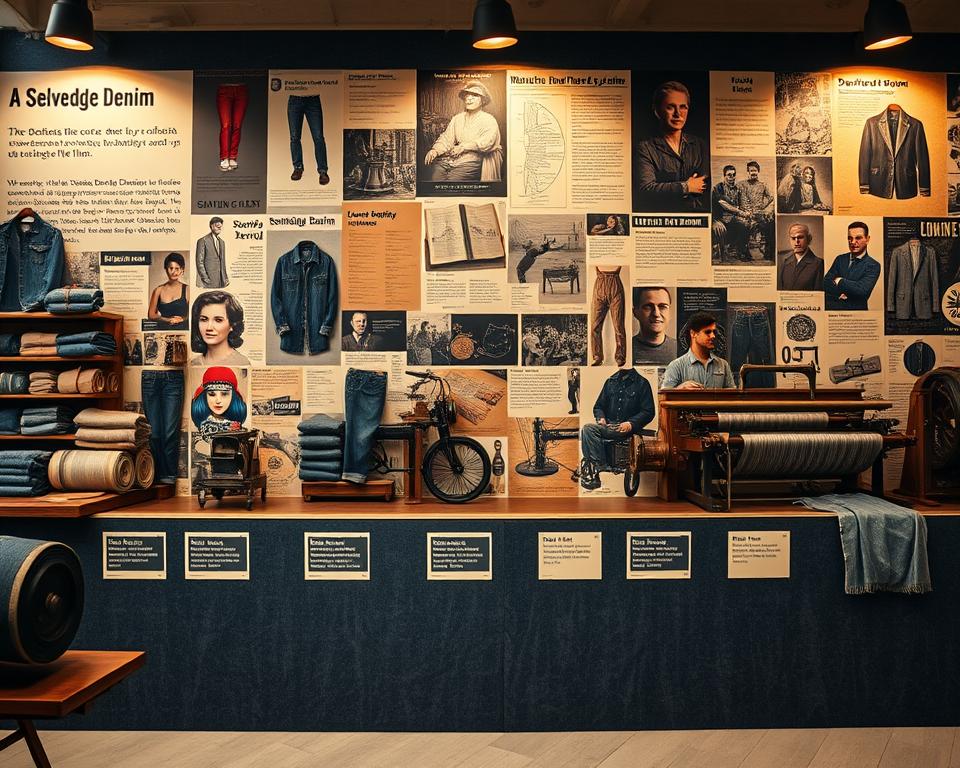The Ultimate Manual to Premium denim Edge-to-Edge Fabric
Ever questioned why some trousers seem as though they are built for endurance a lifetime? The secret lies in the elements and skill. Take, for instance, the rising trend of premium selvedge. This goes beyond common textile—it attests to excellence and heritage.
Nowadays, a growing number of people are turning to these timeless fabrics for their robustness and classic selvedge denim by the yard appeal. Be it that you are a DIY sewist or a denim lover, there’s a unique quality about using top-grade cotton and yarn. It isn’t solely concerned with constructing pants; it involves crafting a narrative.
Here at Core Fabrics, we’ve assembled a collection of 14.25oz organic cotton and elastic variants. These fabrics are ideal for a spectrum ranging from raw jeans to couture jacket blueprints. Prepared to dive into the realm of top-tier fabrics? Let’s jump right in.
What Is Denim Selvedge Fabric?
What makes some trousers stand out with their unique, finished without extra steps seams? The key resides in the selvedge denim, a superior fabric renowned for its robustness and vintage appeal. In contrast to standard textiles, this type of fabric is produced using classic methods that have stood the test of time.
What Selvedge Denim Means
Selvedge denim is manufactured using retro shuttle looms, which generate minimal widths of about 30-35 inches. These looms weave the material in a method that delivers self-finished borders, often highlighted by a distinctive red line. This process ensures the material is densely interlaced and exceptionally sturdy.
Modern looms, alternatively, generate expansive fabric but lack the same level of artistry. The imperfections in selvedge, like twists in the leg or inconsistent patterns, are embraced as part of its charm. This approach, termed “wabi-sabi”, honors the aesthetic of inherent flaws.
The Making of Selvedge Denim
The manufacturing of selvedge denim involves a detailed process. Traditional shuttle looms interlace the filling yarns back and forth, creating a dense and sturdy fabric. Unlike modern methods with modern looms, which prioritize speed and efficiency over craftsmanship.
Labels such as Karson Denim uphold traditional Japanese methods from the 90s. They intentionally include anomalies to preserve the genuineness of the textile. Each piece is graded on a four-point system, ensuring it fulfills the peak requirements of quality.
| Feature | Selvedge Denim | Modern Denim |
|---|---|---|
| Measure | 30-35 inches | 60+ inches |
| Construction Technique | Classic Shuttle Loom | Modern Loom |
| Texture | Irregular, Flawed | Consistent |
| Strength | High | Average |
“The charm of selvedge is found in its flaws—each flaw tells a story skill and legacy.”
The History of Selvedge Denim
From humble beginnings to worldwide renown, the tale of these materials is multifaceted and inspiring. What started as durable workwear in seventeenth-century France transformed into a mark of everlasting fashion and craftsmanship.
Beginnings in Craftsmanship
The origin of this fabric reaches back to Nîmes, France, where it was dubbed “serge de Nîmes.” First intended for workers, it was crafted out of hardwearing cotton and thread. Its durability ensured its popularity among laborers during the era of the Gold Rush.
In the 20th century, it had become a staple for pants. The closure of the Cone Mills White Oak factory became a pivotal moment. This transition enabled Japanese craftsmen to revive classic fabric-making practices.

Evolution in Modern Denim Production
Post-WWII, Japan developed a deep appreciation for retro American culture. Craftsmen repaired classic looms to create authentic reproductions. This dedication to quality secured the survival of selvedge as a specialty product.
In modern times, advancements from Italy and Turkey have introduced environmentally conscious combinations and flexible selections. These modernizations have enhanced the attraction of this everlasting material. Within Core Fabrics, we procure internationally, from Montréal to Asia, to bring you the best quality.
“The legacy of selvedge is a tribute to the lasting worth of craftsmanship and legacy.”
Why Choose Selvedge Denim?
Why does selvedge denim shine in the world of top-tier fabrics? Its unique qualities and incomparable robustness render it popular among aficionados and stylists alike. Be it that you are crafting pants or a structured jacket, this textile provides a fusion of heritage and updated style.
Unique Qualities of Selvedge Fabric
Selvedge denim is celebrated for its dense construction, which enhances tear resistance and fade potential. Differing from regular textiles, rainbow selvedge denim is crafted using traditional shuttle looms, resulting in a more compact and exceptionally sturdy fabric. In doing so, it secures that each piece has a singular finish and individuality.
Notable attributes are:
- Hairy, rigid raw denim contrasts with laundered, relaxed stretch options.
- The sanforization process ensures predictable sizing, while untreated fabrics provide a dynamic fitting process.
- Variants include 9.5oz Eco Finish to 14.25oz Organic, meeting varied requirements.
Durability and Longevity
One of the most remarkable aspects of selvedge denim is its long life. The dense fabric structure both reinforces strength and permits distinctive color fades over time. This makes it a wise purchase for those seeking enduring style.
Main considerations:
- Mid-weight fabrics from 12oz to 14oz work well for tailored jackets and evolving jeans.
- Opt for the 14.25oz True Indigo for traditional jean lifespan.
- Eco-friendly options, like recycled cotton and indigo blends, add sustainability to your wardrobe.
At Core Fabrics, our collection includes a variety of options to suit your needs. Spanning from raw finishes to sanforized treatments, each selection is designed for superior quality and value.
Selvedge vs. Wide Denim: A Comparison
When it comes to crafting durable and stylish garments, the decision of textile is pivotal. Two common choices include selvedge and wide denim, both offering different features. Knowing how they differ assists in selecting the right one for your endeavor.
Contrasting Weave Techniques
Selvedge denim is produced using classic shuttle looms, producing limited spans of 30-35 inches. This herringbone denim material process forms firm borders, often marked by a characteristic red line. In contrast, wide denim is produced using modern projectile looms, yielding expansive widths of over 60 inches.
Old-style shuttle looms yield roughly 3m per minute, while projectile looms can produce up to 30 meters per minute. Such speed differences influence both the expense and the texture of the outcome.
Benefits and Drawbacks
Selvedge denim is celebrated for its superior quality and strength. Its slender dimension renders it perfect for creations where exposed edges or decorative patches are required. However, it can be costlier, typically around $23 per meter.
Wide denim is economical, priced around $8 per half-meter. Its wider width minimizes excess, making it suitable for big-scale works like upholstery. However, it lacks the distinctive selvage detail of selvedge.
| Feature | Selvedge Denim | Wide Denim |
|---|---|---|
| Width | 30-35 inches | 60+ inches |
| Method | Traditional Shuttle | Contemporary Projectile Loom |
| Rate | 3m/min | 30m/min |
| Cost | $23/meter | $8 per half-meter |
For defined borders as seen in Grainline Thayer jackets, selvedge is favored. Conversely, wide denim is ideal for extensive projects due to its efficiency. Evaluate your project specifications to choose wisely.
Working with Selvedge Denim
Working with premium materials can elevate your sewing projects to the next level. Whether you’re crafting jeans, blazers, or frocks, knowing how to measure, sew, and care for the material secures expert outcomes. Let’s delve into the optimal use of this classic material.
Yardage Needed for Jeans and Jackets
It is essential to compute the correct fabric amount when designing your creation. Approximately 3-3.3 yards is necessary for men’s jeans, considering defects and shrinkage. Trucker-style jackets generally demand about 3.3 yards, while skirts can be made with just 2 yards.
Innovative layout techniques can mitigate fabric flaws. Instead of cutting around defects, consider integrating them into your design for a unique look.
| Item | Required Yardage |
|---|---|
| Male Jeans | 3-3.3 yards |
| Trucker Jacket | 3.3 yards |
| Skirt Item | 2 yards |
Advice for Sewing and Longevity
The correct gear and skills secure a refined outcome. Select #70 to 110 needle sizes and presser foot attachments made for robust textiles. Use Gütermann rPET thread for effective contrast stitching.
Additional advice includes:
- Use a tailor’s clapper for sharp creases without shine.
- Our denim kits from Core Fabrics comprise topstitch thread, rivets, and 9mm jeans buttons to ensure a refined result.
- Structured edges, essential for jackets, are best achieved with selvedge.
Maintaining your pieces properly increases their longevity. Use minimal washing and opt for air drying to preserve fabric quality. With these tips, your projects will stand the test of time.
Wrapping It Up
Crafting with premium materials isn’t just about durability—it’s about creating something with character. Selvedge denim epitomizes this philosophy, merging craftsman allure with long-lasting quality. Whether you’re sewing jeans or a structured jacket, this material tells a story with every stitch.
With Core Fabrics, unleashing your creative potential is effortless. Experience our swatch service to gauge texture and weight prior to purchase. Plus, enjoy free shipping on orders over $150 USD across North America.
Eco-friendly mixtures and classic washes are paving the way for the next generation of cotton fabrics. They open fresh avenues for merging sustainability with chic style.
Eager to explore top-tier textiles? Shop now and discover the value of crafting with purpose. Your next project could be a timeless piece that lasts for years to come.


